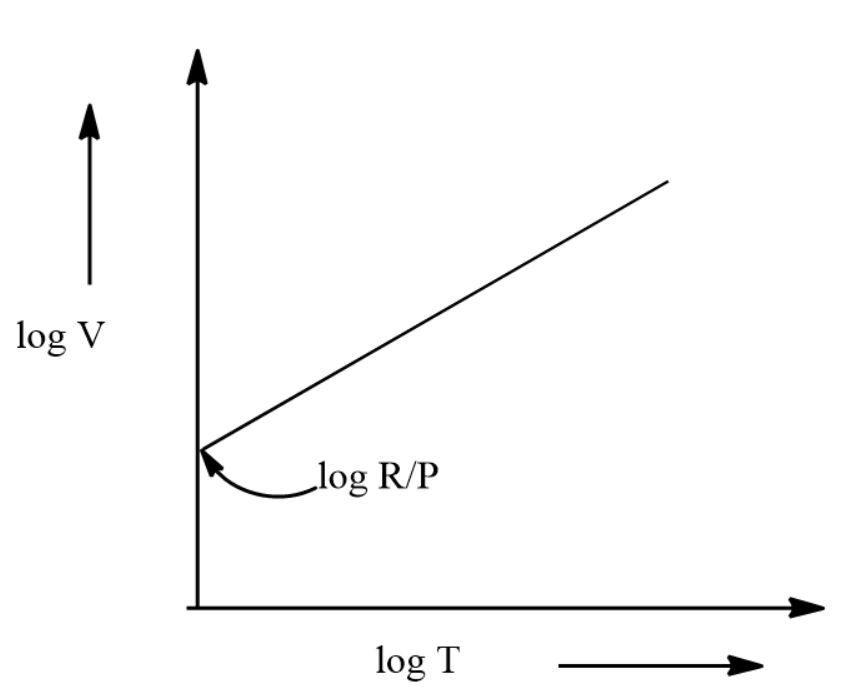
The plots of log V vs. log T at constant P for 1 mole of an ideal gas gives intercept equal to:
A.\[\log \dfrac{P}{R}\]
B.\[ - \dfrac{P}{R}\]
C.\[ - \dfrac{R}{P}\]
D.\[\log \dfrac{R}{P}\]
Answer
486.9k+ views
Hint: We can use the ideal gas equation to solve this problem. The ideal gas equation can be rearranged to obtain the graph. We know that the log V vs log T graph will yield us a straight line. By using the straight-line equation, we can say that y=mx+c and thus the value of c will give us the value of the intercept.
Complete answer:
According to the ideal gas equation we can say that
\[ \Rightarrow PV = nRT\]
This means that the pressure, volume, Temperature and the universal gas constant R can be related by this formula.
According to the question, we are given 1 mole of the gas. This means that the value of n=1.
Thus the equation becomes:
\[ \Rightarrow PV = RT\]
Applying logarithm on both the sides we get,
\[ \Rightarrow \log P + \log V = \log R + \log T\]
\[ \Rightarrow \log V = \log R + \log T - \log P\]
By simplifying the logarithm we will obtain:
\[ \Rightarrow \log V = \log \dfrac{R}{P} + \log T\]
This is of the form y=mx+c
Here log V is in the y-axis and log T is in the x-axis. Thus we can say that the value of c will be \[\log \dfrac{R}{P}\] .
The graph of the equation will be given by:

Hence the correct answer is option D.
Note:
While doing the simplification of the log terms we are taking the log P term to the right-hand side instead of log V because the value of P is a constant and thus the value of intercept obtained can be a constant. It is mentioned in the question that the experiment is done under constant pressure. Thus we need the intercept term to be a constant value and hence use P in it.
Complete answer:
According to the ideal gas equation we can say that
\[ \Rightarrow PV = nRT\]
This means that the pressure, volume, Temperature and the universal gas constant R can be related by this formula.
According to the question, we are given 1 mole of the gas. This means that the value of n=1.
Thus the equation becomes:
\[ \Rightarrow PV = RT\]
Applying logarithm on both the sides we get,
\[ \Rightarrow \log P + \log V = \log R + \log T\]
\[ \Rightarrow \log V = \log R + \log T - \log P\]
By simplifying the logarithm we will obtain:
\[ \Rightarrow \log V = \log \dfrac{R}{P} + \log T\]
This is of the form y=mx+c
Here log V is in the y-axis and log T is in the x-axis. Thus we can say that the value of c will be \[\log \dfrac{R}{P}\] .
The graph of the equation will be given by:

Hence the correct answer is option D.
Note:
While doing the simplification of the log terms we are taking the log P term to the right-hand side instead of log V because the value of P is a constant and thus the value of intercept obtained can be a constant. It is mentioned in the question that the experiment is done under constant pressure. Thus we need the intercept term to be a constant value and hence use P in it.
Recently Updated Pages
Why are manures considered better than fertilizers class 11 biology CBSE

Find the coordinates of the midpoint of the line segment class 11 maths CBSE

Distinguish between static friction limiting friction class 11 physics CBSE

The Chairman of the constituent Assembly was A Jawaharlal class 11 social science CBSE

The first National Commission on Labour NCL submitted class 11 social science CBSE

Number of all subshell of n + l 7 is A 4 B 5 C 6 D class 11 chemistry CBSE

Trending doubts
What is meant by exothermic and endothermic reactions class 11 chemistry CBSE

10 examples of friction in our daily life

One Metric ton is equal to kg A 10000 B 1000 C 100 class 11 physics CBSE

1 Quintal is equal to a 110 kg b 10 kg c 100kg d 1000 class 11 physics CBSE

Difference Between Prokaryotic Cells and Eukaryotic Cells

What are Quantum numbers Explain the quantum number class 11 chemistry CBSE




